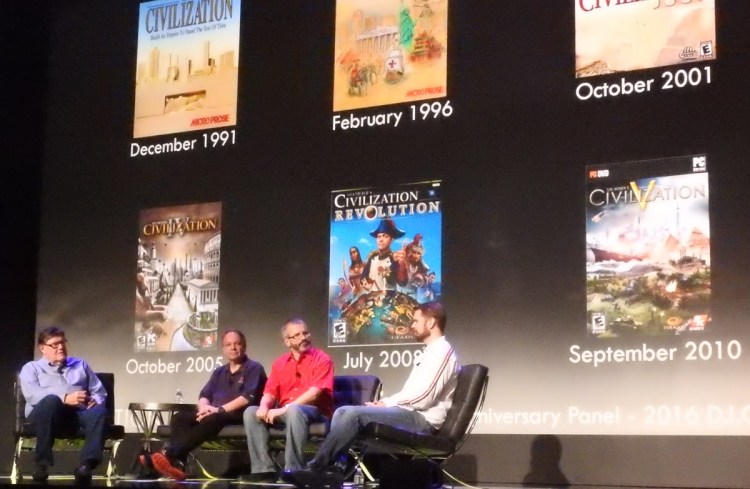LAS VEGAS — Civilization is one of the gods of strategy games, where you oversee the creation of a whole society in competition with other civilizations. It debuted in 1991, and now at 25, it has become one of the cultural touchstones of the game industry, something that everyone recognizes or has played in the past.
Few game franchises live to see a 25th anniversary, but Civ, as most gamers and industry folk call it, is thriving. It has 33 million copies in sales to date, including 8 million for its latest, 2010’s Civilization V and its expansions. Meier’s teams at MicroProse and Firaxis have created 66 versions of the game across all platforms, and based on extrapolations from sales on the Steam digital distribution and community platform, the Civ series has been played for more than a billion hours.
Civ game designers from across those 25 years — Bruce Shelley, Sid Meier, Brian Reynolds, and Soren Johnson — got together in a panel at the DICE Summit today, the game event in Las Vegas, to talk about the design and impact of Civ throughout the years. (See our own interview with Meier).
At the time the game came out, Sim City and Populous had already debuted in the “god games” genre. But Civ was still unique in how it tried to simulate all of human history.
“We felt the game was fun,” Meier said. “There was no game like this. We could break new ground and make it work.”
Meier said the game had its started in a “golden period of MicroProse,” after the company had shipped hit games like Railroad Tycoon, Covert Action, Pirates!, and various flight simulators.
“There was a hint that strategy might be something cool,” Meier said. “Beyond railroads, what was an epic topic for simulation? We wanted to end up with something big. What about the history of Civilization? We were inspired by SimCity with god games. The core was a number of simple systems: economic, combat, growth. Everything was understandable on its own. Once it all interacted, the decisions for the player became very interesting.”
Players talk about their obsession with playing Civ, and Reynolds brought up the promo for the game, of playing “just one more turn,” as one of its hallmarks. Civ had great gameplay, great topic, and accessibility, Johnson said. And players could feel like they controlled the game, as the designers weren’t heavy-handed about the direction the game could flow.
“It followed that pattern for 25 years,” Johnson.
Each game came with its own creative pressures, and Meier gladly handed over the design to others who had ideas to push the series forward. The ability to simulate the societies in the game, based on the improvements in computing power, made it possible to create more and more realistic Civ worlds. A look at the art of the early Civ games and the latest give you a full view of the arc of technological improvement in graphics.
But the designers still had to come up with new features, beyond better graphics, in each new game.
“I didn’t want to go down in history as the guy who broke Civilization,” Reynolds said.
The original Civilization was made with a 16-color palette. With Civ II, Windows came along and made PC gaming more palatable for larger audiences. Now the game can take advantage of millions of colors.
“Brian disappeared for a year, went to England, and came back with Civilization II,” Meier said.
Reynolds said the game was projected to sell about 38,000 copies. It beat that projection many times over.
On Civ III and IV, the game kept adding new things to do, such as adding special characters called known as great people and religion.
“We wanted to bring old ideas forward and still start from scratch,” Johnson said.
For Civ IV, Johnson operated on the ideas of “one-third old, one-third improved, and one-third new,” so new fans could embrace the game and old fans could enjoy familiar features.
Meier said, “Some franchises go into overly large, overly complex ideas and crashed and burned.”
Meier took a stab in 2008 at packing Civ into mobile with Civilization Revolution, or an introductory version of the game with more bite-sized gameplay.
Meier said the franchise has likely remained popular for 25 years, and kept its magic, because of the community support.
“So many of their ideas and energy has gone into the game,” Meier said. “Brian introduced the idea of modding into Civ II, and the game took off.
“Something about Civ seems to bring out the game designer in people. We would get letters, with fans saying ‘This is what i would change about it.'”
A recent Firaxis Con event featured a multi-generational crowd, where parents were bring their kids to introduce the game to the new generation, Meier said.
“The whole arc of human history and you get to be the ruler. We would sneak in actual history, and play on the things people already knew about history. It goes to a common history we all have and the core desire to rule it all,” Reynolds said.
VentureBeat's mission is to be a digital town square for technical decision-makers to gain knowledge about transformative enterprise technology and transact. Learn More





